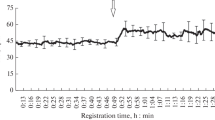Abstract
The work deals with study of basic characteristics of cardiac activity (heart rate—HR and stress-index—SI) and hemolymph protein parameters in the crayfish Pontastacus leptodactylus. The main criteria of the crayfish selection are developed for formation of the animal reference groups available for subsequent toxicological experiments. The action of a model toxicant, hydroquinone (often present in waste water), at a concentration of 1 g/l on parameters of the crayfish cardiac activity at various exposition time, its effect on circadian cardioactivity and on the hemolymph total protein were studied. At its short-term action, hydroquinone produced a temporary increase of HR and stress-index, but had no marked effect on total protein parameters in hemolymph. At long action (for one day), hydroquinone led to a considerable tachycardia, disturbance of the circadian cardioactivity and to a decrease by 40% of the hemolymph total protein. In 50% of cases the toxicant caused death of the animals either in the course of its short-term action or at period of washout from the toxicant. Mechanisms of the toxic action of hydroquinone at various levels of organization are discussed.
Similar content being viewed by others
References
Zubov, A.N., Analysis of the Salt Stimulus in the Lower Animals (Daphnia pulex), Vopr. Sravnit. Fiziol. Analizat., 1960, no. 1, pp. 123–136.
Sokolov, V.A., About Unconditioned Reflex Reactions of Crayfishes to Sodium Chloride Solutions, Vopr. Sravnit. Fiziol. Analizat., 1960, no. 1, pp. 190–195.
Depledge, M.H., Aagaard, A., and Gyorkis, P., Assessment of Track Metal Toxicity Using Molecular, Physiological and Behavioral Biomarkers, Mar. Pollut. Bull., 1995, vol.31, pp. 19–27.
Depledge, M.H. and Andersen, B.B., A Computer-Aided Physiological Monitoring System for Continuous, Long-term Recording of Cardiac Activity in Selected Invertebrates, Comp. Biochem. Physiol., 1991, vol. 9, pp. 474–477.
Bamber, S.D. and Depledge, M.H., Evaluation of Changes in the Adaptive Physiology of Shore Crabs (Carcinus maenas) as an Indicator of Pollution in Estuarine Environments, Mar. Biol., 1997, vol. 129, pp. 667–672.
Bloxham, M.J., Worsword, P.J., and Depledge, M.H., Integrative Biological and Chemical Monitoring, Ecotoxicology, 1999, vol. 6, pp. 225–237.
Cherkinskii, S.N., Sanitarnye usloviya spuska stochnykh vod v vodoemy (The Sanitary Conditions of the Waste Water Input into Reservoirs), Moscow, 1971.
Fedotov, V.P., Kholodkevich, S.V., and Strochilo, A.G., Study of the Contractile Activity of the Crayfish Heart with Aid of a New Noninvasive Method, Zh. Evol. Biokhim. Fiziol., 2000, vol. 36, pp. 219–222.
Kholodkevich, S.V., Fedotov, V.P., Kuznetsova, T.V., Ivanova, V.P., Kurakin, A.S., and Kornienko, E.L., Fiberoptic Remote Biosensor Systems for Permanent Biological Monitoring of the Surface Waters Quality and Bottom Sediments in the Real Time, http:/www.ices.dli/products/CM-docs/CM-2007/I/I-2007.
Kholodkevich, S.V., Ivanov, A.V., Kurakin, A.S., Kornienko, E.L., and Fedotov, V.P., Real Time Biomonitoring of Surface Water Toxicity Level at Water Supply Stations, Environ. Bioindic., 2008, vol. 3, no. 1, pp. 23–34.
Lowry, O., Rosebrough, N., Farr, A., and Randale, R., Protein Measurement with the Folin Phenol Reagent, J. Biol. Chem., 1951, vol. 93, pp. 265–275.
Baevskii, R.M. and Berseneva, A.P., Otsenka adaptatszionnyikh vozmozhnostei organizma i risk razvitiya zabolevanii (Evaluation of the Organism Adaptive Possibilities and Risk of Development of Diseases), Moscow, 1997.
Cherkashina, N.Ya., Dinamika populyatsii rakov roda Pontastacus i Caspiastacus (Crustacea, Decapoda, Astacidae) i puti ikh uvelicheniya (Population Dynamics of the Crayfish Pontastacus and Caspiastacus (Crustacea, Decapoda, Astacidae) and Pathways of Their Increase), Moscow, 2002.
Tsukersis, Ya.M., Biologiya shirokopalogo raka (Biology of Astacus astacus), Vilnius, 1970.
Florkin, P.I., Blood Chemistry, Physiology of Crustacea, 10, New York, 1960.
Chaisemartin, C., Effect du Taux des Proteins Alimentaires sur Differents “Indeces” Physiologiques cher l’Ecrevisse Austropotamobius pallipes (Lereboullet), Freshwater Crayfish. Fourth International Symposium on Freshwater Crayfish, Laurent, Pierre-J., Ed., Thononles-Bains, France, 1978, pp. 43–51.
Styrishave, B., Rasmusson, A.D., and Depledge, M.H., The Influence of Bulk and Trace Metals on the Circadian Rhythmicity of Heart Rates in Freshwater Crayfish Astacus astacus, Mar. Poll. Bull., 1995, vol. 31, pp. 87–92.
Bojsen, B.P., Witthofft, H., and Styrishave, B., In situ Studies on Heart Rate and Locomotor Activity in the Noble Freshwater Crayfish (Astacus astacus L.) in Relation to Natural Fluctuations in Temperature and Light Intensity, Freshwater Biol., 1998, vol. 39, pp. 455–465.
IPCS. Environmental Health Criteria 157: Hydroquinone, Geneva, 1994.
Kiknadze, K.S., Esakov, B.P., Kuzminykh, S.B., and Komarov, V.N., The Automated Method of Evaluation of the Water Environment Pollution, Based on Recording of Heart Beat Period of Daphnia, Metody Bioindikatsii i Biotestirovaniya Prirodnykh Vod (Methods of Bioindication and Biotesting of Natural Waters), Iss. 1, 1987, pp. 25–34.
Labori, O., Regulyatsiya obmennykh protsessov (Regulation of Metabolic Processes), Moscow, 1970.
Kuznetsov, S.V., Mechanisms of Reproduction of Ancient Excitation Rhythms in the Physiological Processes, Doctorate Sci. Dissertation, St. Petersburg, 2006.
Prosser, K.L., Sravnitel’naya fiziologiya zhivotnykh (Animal Comparative Physiology), vol. 2, Moscow, 1977.
Tahon, J.P., van Hoof, D., Vinckier, C., Witters, R., de Ley, M., and Lontie, R., The Reaction of Nitrite with the Haemocyanin of Astacus leptodactylus, Biochem. J., 1988, vol. 249, pp. 891–896.
Kutsenko, S.A., Osnovy toksikologii (Grounds of Toxicology), St. Petersburg, 2002.
Author information
Authors and Affiliations
Additional information
Original Russian Text © T. V. Kuznetsova, G. V. Sladkova, S. V. Kholodkevich, 2010, published in Zhurnal Evolyutsionnoi Biokhimii i Fiziologii, 2010, Vol. 46, No. 3, pp. 203–210.
Rights and permissions
About this article
Cite this article
Kuznetsova, T.V., Sladkova, G.V. & Kholodkevich, S.V. Evaluation of functional state of crayfish Pontastacus leptodactylus in normal and toxic environment by characteristics of their cardiac activity and hemolymph biochemical parameters. J Evol Biochem Phys 46, 241–250 (2010). https://doi.org/10.1134/S0022093010030038
Received:
Published:
Issue Date:
DOI: https://doi.org/10.1134/S0022093010030038




